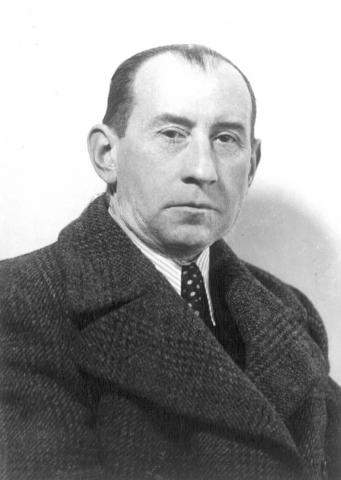Leopold Ruprecht was born in 1889 in Laxenburg near Vienna as the son of the architect Ludwig Ruprecht and Viktorine, née Halm. He studied art history in Vienna with Max Dvořák and was awarded a doctoral degree in 1914 with a thesis entitled Die Entwicklung der Aetzmalerei auf Erzeugnissen deutscher Plattnerwerkstätten. He completed a course at the Austrian Institute of Historical Research. While still a student, he worked in the Collection of Weapons and Industrial Art in the Kunsthistorisches Museum (KHM) under the directorship of Camillo List. He served in the army from autumn 1914 and was captured by the Russians in 1916, returning from captivity in 1920. Until 1933 he was an expert in weapons and applied art in the Dorotheum. From 1924 to 1927 he was managing director, together with the monument preservationist and later provincial preservationist for Upper Danube Franz Juraschek, of Krystall-Verlag, which published the magazine Belvedere and also art history periodicals and art books. Ruprecht had close contacts with the NSDAP from 1930 and joined the Party in 1932. In July 1938 he took over as head of the KHM weapons collection, succeeding August Grósz, who was permanently retired in May 1938. Bruno Thomas, the interim director of the weapons collection was demoted to curator. Ruprecht's first task was to catalogue the seized Jewish collections in the Central Depot in the Neue Burg. He also deputized for Fritz Dworschak, the provisional director of the KHM, as manager of the Central Depot. At Easter 1943, Ruprecht was entrusted on Dworschak's recommendation with compiling a weapons collection for the "Führermuseum". Together with his colleague Hans Schedelmann he made several visits from 1943 onwards to Altaussee. According to the Linz Report written by Samson Lane Faison from the Art Looting Investigation Unit, Ruprecht was responsible for the confiscation of several weapons collections in Czechoslovakia and accompanied Kajetan Mühlmann to Poland to inspect seized armour. He also travelled in late December 1944 with Martin Bormann's private secretary Helmut von Hummel and the art dealer Eugen Brüschwiler to South Tyrol. In January 1945 he visited Italy as part of the "Sonderauftrag Linz". In May 1945 he was captured by US soldiers in the Salzkammergut while attempting to escape and interrogated in Zell am See. Because of his earlier NSDAP membership, the KHM dismissed him on 6 June 1945 in accordance with Section 14 of the Prohibition Act. In summer 1945 his home was searched as he was suspected of harbouring objects from the Teutonic Order, the KHM and the "Sonderauftrag Linz". He was accused by the Volksgericht of "illegal enrichment" (§ 6 of the War Criminals Act) and "illegality" (§ 10 VG) but the case was discontinued in 1948. Books were found in Ruprecht's former office in the KHM that were shown to have been owned by Nathaniel and Alphonse Rothschild, among others. The whereabouts of these books is unknown. Ruprecht did not return to Vienna but in November 1948 had two crates stored in the KHM containing porcelain and glass given to his authorized representative Karl Vogel, which "Dr. Ruprecht had purchased from the Liquidation Commissar". Ruprecht lived until his death in 1967 in Fusch an der Glocknerstraße.
Leopold Ruprecht

Herbert Haupt, Getroffen, doch nicht vernichtet. Das Kunsthistorische Museum im Kriegsjahr 1945. Eine Chronologie der Ereignisse in Bildern, Wien 2005.
Kathrin Iselt, "Sonderbeauftragter des Führers". Der Kunsthistoriker und Museumsman Hermann Voss (1884–1969), Köln-Weimar-Wien 2010.
Andrzej Mezynski, Kommando Paulsen, Organisierter Kunstraub in Polen 1942–45, Köln 2000.
Leopold Ruprecht, Ein Galadegen aus der Werkstatt eines Salzburger Medailleurs, in: Belvedere 5 (1924), 153.
Leopold Ruprecht, Die Gläser des 19. Jahrhunderts der Sammlung Franz Ruhmann in Wien, in: Belvedere 11 (1927), 118–121.
Leopold Ruprecht, Porzellansammlung Berta Floderer-Herzfelder, Wien, in: Belvedere 12 (1928), 69–70, 95–96.
Leopold Ruprecht, Sonderschau der Waffensammlung, Wien 1941.
Leopold Ruprecht, Kunsthistorisches Museum in Wien: Waffensammlung; Sonderschau in der Neuen Burg; Rüstungen und Waffen; Rückführungen aus dem Musée de l'Armée in Paris, Wien 1941.
Dorotheum, Pro Domo Vermerk zu Leopold Ruprecht.
KHM-Archiv, Direktionakten: 100/KL/1938, 330/KL/1938, 93/KL/1939, 119/KL/1939, 44/KL/1941, 46/KL/1941, 229/KL/1941, 277/KL/1941, 123/ED/1942, 41/ED/1944, 7/ED/1945, 33/ED/1945, 109/ED/1948, 110/ED/1948; Sammlungsakten: 76/AR/2011.
Consolidated Interrogation Report No. 4. Linz: Hitler's Museum and Library. 15 December 1945, URL: www.fold3.com/browse/1/hFmE5NRe5ijUFn0aw0FRJRrY1 (9.1.2019).
OeStA/AdR, UWK, BMU, Kunstangelegenheiten, Signatur 15, K. 174, Museen 1940–1946.
OeStA/AdR, UWK, BMU, Personalakten, 03/145, 04/162, Leopold Ruprecht.
WStLA, Gauakten, A1, Personalakten des Gaues Wien, Leopold Ruprecht.
WStLA, Volksgericht, A1, VgVr 3634/48, Leopold Ruprecht.
